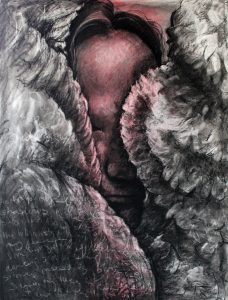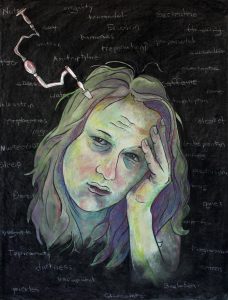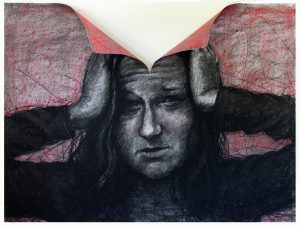

By: Gail Obenreder
“I love painting, but with drawing . . . I fall in and get lost in the sheer joy of it.”
Maia Palmer has always loved drawing. In Sunday School, while other children were copying from a book, she made an original drawing of Peter Rabbit and was showered with praise. “Aglow with [adult] admiration, I decided that I should draw more,” the first time – but certainly not the last – that Palmer used drawing “as a means of initiating conversation with others.”
Early in her art career, Palmer also explored “the lure of oil painting, foundry and metal casting, and digital art.” But recently, she circled back to focus on drawing, digitally creating coloring and comic books and working with a traditional medium, charcoal. “I’m drawn to the immediacy of drawing . . . the grittiness of charcoal. I love that I can work directly with my hands on the paper.”
As a portrait artist, Palmer continues to use art to initiate communication – “my subject becomes my partner in conversation.” Much of her work has been portraiture of others, including a pandemic quarantine series of coloring-book portraits made “to create community from a safe distance.” But her Fellowship drawings feature Palmer as “my own subject, exploring how my identity has been altered by living with chronic migraine.” This work gifted the artist with a new type of community: “It has been affirming to have positive feedback from others who have reached out to me as fellow sufferers.”



Palmer is that rare thing – a Delaware native. With her sister, she grew up in Wilmington in a family blended by her parents’ divorce. “We were lucky to have scored four awesome parents and an extra sister!” But the peripatetic artist has lived and worked worldwide. After graduating with an art degree from Carnegie Mellon University (Pittsburgh), she studied art in Spain and Japanese language in Hiroshima and worked as an artist in Berlin. In the U.S. Palmer has lived and worked in Hawaii, Seattle, and St. Louis, where she created a mural arts program for girls aged 7-14 in collaboration with a friend. “This sparked in me a vested interest in becoming a full-time art teacher,” and she returned to Delaware in 2014 to live and teach.
Early on, Palmer was drawn to the work of Georgia O’Keefe and has recently been studying the contemporary works of Kehinde Wiley and Kartoon Kings (Simon Grennan and Christopher Sperandio), artists who involve subjects in the artwork’s development. And as she made her most recent drawings, Palmer was inspired by the “gorgeous portraits” of Kathe Kollwitz. “I thought about her work a lot as I worked on my migraine series.”
As well as a passionate commitment to her artistic practice – ongoing throughout the pandemic – Palmer loves playing the piano, salsa dancing, and “flying through the air on aerial hoops or silks.” Committed to “being a positive force for social change,” she is active in the community and with the Delaware Art Education Association. Now a visual arts teacher at Cab Calloway School of the Arts, she feels strongly about teaching there. “I am a product of public school and I want to be part of rebuilding its strength.”
One of the most exciting aspects of receiving the Fellowship is “the recognition of my work” and the ability to further its scope and her goal to “help amplify the voices of those who are not always heard.”
Fellowship Home